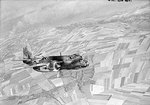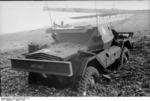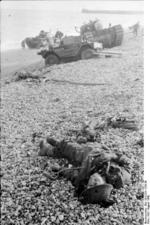![Attack on Dieppe file photo [6579] Attack on Dieppe file photo [6579]](/images/battle_dieppe1.jpg)
Attack on Dieppe
Contributor: C. Peter Chen
ww2dbaseLord Louis Mountbatten, Chief of Combined Operations, wanted to finally strike continental Europe and perhaps even cause Germany to reinforce the French coast with troops destined for the Eastern Front, therefore alleviating pressure off of the Soviet troops. The Operation Jubilee, as the plan was code named, called for a landing at Dieppe on the French coast, hold beach head for 12 hours while commando units attacked a nearby German HQ and bring back German officers for interrogation, and then the entire force would retreat back to England.
ww2dbaseOn 18 Aug 1942, 237 ships left various ports in Britain for the Dieppe area, including eight destroyers but no battleships (the Admiralty did not wish to risk losing any heavy ships). The convoy carried 5,000 Canadian, 1,000 British, and 50 American troops; it was escorted by 74 squadrons of aircraft. A stroke a bad luck brought the Allied fleet in the path of a German convoy; the convoy was quickly driven off, but German defenses were alerted. 80% of the Allied fleet would be destroyed by the alerted German coastal defenses. Only a few commandos reached their landing spots on 19 Aug, but they were able to improvise their plans; instead of destroying the coastal artillery, they managed to kill many of the gun crews by sniper fire and disabled the artillery nevertheless. The Canadian landing at Puys failed completely, the well-placed German forces drove off the Canadian landing, killing roughly half the landing force (225) and captured the other half (264), allowing only 33 to escape back to England. At Pourville, Canadian and British troops made their landing, but was quickly driven back to the sea by fierce German defenses after losing 141 men. As for the main assault, some of the landing forces were held at the beach by heavy fire, while some of the tanks either did not make it to the shore or were disabled by anti-tank traps. The reserve forces were also committed too early due to communications problems.
ww2dbaseIn all, the operation met with failure due to a number of reasons. However, if the 1,027 men lost (900 of whom were Canadian) and 2,340 captured (again, with a bulk being Canadian) had achieved one objective, it was giving Allied command a valuable, if costly, lesson on amphibious operations. Mountbatten himself said that "for every soldier who died at Dieppe, ten were saved on D-Day". While this statement may have been out of Mountbatten's attempt to save his credibility, it indeed had given the United States the valuable lesson of the difficulty of assaulting a defended port. This experience might have directly influenced General Eisenhower's decision to strike at the beaches at Normandy instead of the nearby port city of Cherbourg (among other targets).
ww2dbaseSource: the Second World War, Wikipedia.
Last Major Update: Jul 2005
Attack on Dieppe Interactive Map
Photographs
 |  |  |  |
Attack on Dieppe Timeline
| 13 May 1942 | The British Chiefs of Staff approved a major raid against the French port of Dieppe. |
| 11 Jun 1942 | Troops of the 2nd Canadian Division conducted practice for the raid on Dieppe. |
| 1 Jul 1942 | General Montgomery informed General Paget that Operation Rutter, the attack on Dieppe, was to take place on 4 Jul. |
| 4 Jul 1942 | The raid on Dieppe was postponed due to weather. |
| 7 Jul 1942 | Weather caused further postponement of Dieppe raid. |
| 19 Aug 1942 | 5,000 Canadian troops, 1,000 British Commandos, 50 US Rangers, and 58 British Churchill tanks landed at Dieppe, France at 0500 hours in Operation Jubilee via 9 landing ships, covered by 8 destroyers, many smaller warships, and many aircraft. British and Americans were successful in destroying a German battery near Varengeville, but British and Canadian troops on a nearby beach were pinned down, suffering 1,179 killed before the mission's end. As German aircraft counterattacked, British destroyer HMS Berkeley and several smaller ships were sunk. The operation was called off by 1100 hours in dismal failure. 2,190 Allied troops were captured along with all of the tanks and heavy equipment. The British RAF lost 106 aircraft. The Germans suffered only 311 killed and 48 aircraft shot down in the defense. |
| 8 Oct 1942 | A Nazi radio announcement stated that from mid-day (German time) officers and men captured at Dieppe, France had been manacled as a retaliation for the alleged tying of prisoners during a small-scale raid on Sark on 3 October 1942. The British War Office replied that German prisoners brought back from Dieppe had not had their hands tied and had been treaty humanely. It was further threatened that unless the Germans immediately unshackle their captives, then German prisoners of war in Canada would be put into chains from noon 10 October 1942. |
Please consider supporting us on Patreon. Even $1 per month will go a long way! Thank you. Please help us spread the word: Stay updated with WW2DB: |
Visitor Submitted Comments
12 Aug 2009 02:15:16 PM
The Rangers were not even authorised to go on thew raid by the US Government, but having been in training with the British Commandos for some months they were not prepared to be left behind-So they split into small groups and (quite unofficially) joined the Commando troops to take part in the operation.
18 Nov 2011 12:15:56 AM
The Dieppe Raid was a brutal failure of course but maybe it did help the Allied cause in providing lessons learned for future operations like Sicily, Italy and D-DAY? Of course that's no consolation for the majority of Canadian soldiers that were killed or captured on the infamous beach.
The Raid Commander, MG Hamilton Roberts saw his career killed before his very eyes. He would lose command of 2nd Inf.Division soon after the raid.
LTG Andy McNaughton would accept full responsibility for the failure at Dieppe due his position as GOCinC, 1 Canadian Army.
LTG Harry Crerar would move on to become 1 Corps Commander and ultimately replace LTG McNaughton as GOCinC, 1 Canadian Army in 1944.
V/ADM Lord Mountbatten would defend his decisions that would help bring Dieppe Raid into fruition.
13 Sep 2012 08:39:28 AM
During the Dieppe Raid Captain Peter Young of No.3 Commando would play a key role upon which rested the fate of the entire assault. No.3 Commando was tasked with silencing the huge ‘Goebbels’ coastal gun battery sited behind Berneval. Unless this battery was eliminated, the infantry landing ships and destroyers offshore would be in deadly peril.
Unfortunately most of No.3 Commando became scattered when a German convoy of armed trawlers stumbled into their landing craft minutes before they approached the shore. Peter Young’s small group of three officers and seventeen troopers having got ashore managed to creep into a cornfield adjacent to the battery where, hidden from sight, they kept up a withering and demoralising fire on the enemy gunners. After firing just twenty shells at the invasion fleet the two hundred German gunners had suffered such grievous casualties from the Commando’s fire that they attempted to swing a gun around to engage their tormenters in the cornfield. Fortunately the German Gunners could not depress it sufficiently and the shells whistled harmlessly overhead to explode a mile inland.
But this small group of resolute Commandos had provided the invasion fleet with sufficient time to embark their infantry battalions into the smaller landing craft without interference from the coastal guns. With ammunition running short, Captain Young made the decision to retire to the beaches and there, with only two men wounded, re-embarked on Lt Buckee’s landing craft for the return trip to England. For his actions at Dieppe Peter Young would be awarded the Distinguished Service Order (DSO).
All visitor submitted comments are opinions of those making the submissions and do not reflect views of WW2DB.
» Crerar, Henry
» Leigh-Mallory, Trafford
» Mountbatten, Louis
» Zeitzler, Kurt
Location:
» France
- » 1,171 biographies
- » 337 events
- » 44,911 timeline entries
- » 1,244 ships
- » 350 aircraft models
- » 207 vehicle models
- » 376 weapon models
- » 123 historical documents
- » 261 facilities
- » 470 book reviews
- » 28,521 photos
- » 365 maps
James Forrestal, Secretary of the Navy, 23 Feb 1945
Please consider supporting us on Patreon. Even $1 a month will go a long way. Thank you!
Or, please support us by purchasing some WW2DB merchandise at TeeSpring, Thank you!













14 Mar 2006 12:35:27 PM
Yeah - those 50 American troops were Rangers. Headlines in New York papers read: YANKS INVADE EUROPE at the time - with little mention of Canadas major participation...